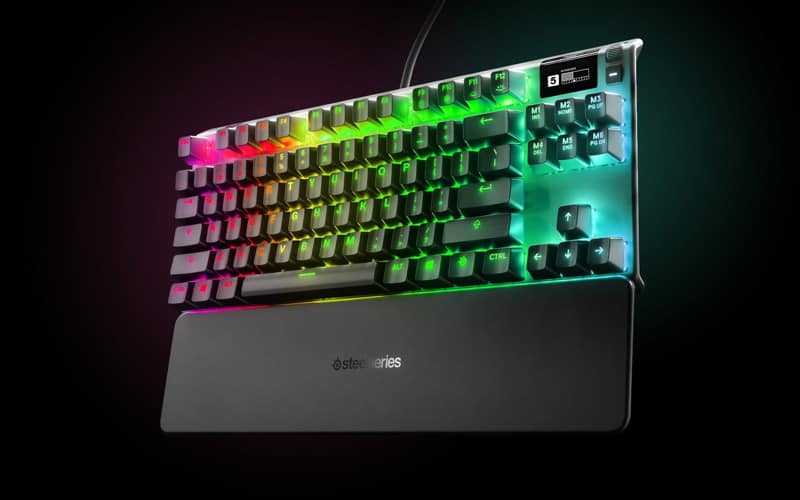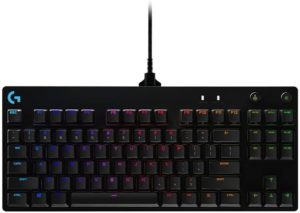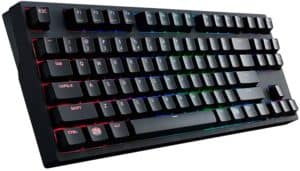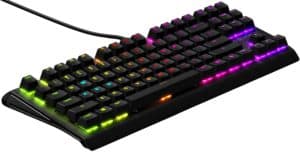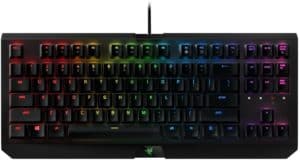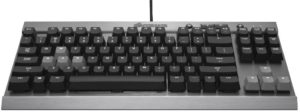Products at a Glance
How we picked
Value, bang for the buck, price to performance – whatever you want to call it, it’s a core factor to consider when scouting out the best TKL mechanical keyboard and one that steered our selection process. Here you’ll find TKL mechanical keyboards that make the most of your cash and won’t leave you nursing pangs of regret.
Alongside, we relied on more keyboard-specific attributes such as the type and feel of the mechanical switches, keycap quality, general construction quality, design, and extras like RGB back-lighting and key bindings/macros. Nothing beats spending time with a keyboard, so we did a lot of that too.
While there’s an abundance of excellent TKL mechanical keyboards out there, we managed to narrow it down to five recommendations. Read on for a review of each and brief pros and cons. For those that want guidance on what to look for when shopping for TKL mechanical keyboards, you’ll find a handy ‘Things to Consider’ section at the end.
We’ve also got some more great keyboard guides – check out the best mechanical keyboards under $100.
Product Reviews
- Durable construction
- Responsive and comfortable clicky switches
- Programmable RGB lighting and F-key macros
- Detachable cable
- Rubber feet with three-step angle adjustment
- Expensive
When piecing together a TKL mechanical keyboard geared towards gamers, nothing beats listening to feedback and suggestions from those that know best – the pros. Logitech has done just that, leveraging its partnerships with the likes of TSM and G2 Esports to create the pro-tested and pro-approved tenkeyless Logitech G PRO Mechanical Gaming Keyboard. While we do have to wade through a bit of marketing blather here, the proof is in the pudding: the Logitech G PRO Mechanical Gaming Keyboard is one hell of a keyboard.
At its heart are Logitech’s proprietary GX Blue switches (based on the Cherry MX Blue). They offer both that satisfying bump mid-way through the keypress travel and that audible click. The actuation point sits at 2.0 mm for a total travel distance of 3.7 mm, while the actuation force is 50 g for just the right amount of resistance. As switches go, they are built for durability, and paired with quality keycaps, are supremely comfortable and a pleasure to use. Durability also bleeds into the rest of the keyboard with solid construction throughout.
This being a Logitech device, the Logitech G PRO Mechanical Gaming Keyboard features fully programmable Lightsync RGB lights, which rather uncommonly sit just under the keycaps to illuminate the letters and numbers. The keys are flush with the case rather than sitting above it as with most mechanical keyboards. You can customize any facet of the RGB lighting via the G HUB software and even load profiles onto the keyboard’s on-board memory. The 12 F-keys are also fully programmable, so you can assign macros as you see fit, too.
Another nice touch is the detachable 1.8 m Micro-USB cable with three-pronged arms to ensure a reliable connection when plugged in. We’re also fans of the rubber feet with three-step adjustment, perfect for honing in on a more comfortable angle.
At roughly $130, possibly a bit less on sale, the Logitech G PRO Mechanical Gaming Keyboard is by no means cheap. Still, as keyboards go, TKL or otherwise, this is among the most enjoyable and comfortable to use and fully warrants that elevated price point.
- Beautifully responsive Cherry MX Blue switches
- Detachable cable
- Customizable RGB lighting
- Sturdy casing
- Convoluted macro configuration
- Short cable
With a compact, minimalist design and free of unnecessary extras, the Cooler Master MasterKeys Pro S is a great option for those that favor well-constructed clicky-style mechanical keyboards.
Rather than proprietary switches, Cooler Master has sourced ‘clicky’ Cherry MX Blue switches. True to form, these are excellent; responsive with that distinctive audible click when hitting that ever-consistent actuation point. As with most mechanical keyboards, the Cooler Master MasterKeys Pro S includes anti-ghosting tech, N-key rollover, and six-key rollover, so even the most furious combination of key-presses are registered correctly and as intended.
On the RGB front, the Cooler Master MasterKeys Pro S has backlit keys that are customizable via Cooler Master software. You can save up to four profiles that are then loaded onto the keyboard’s internal memory. These can be fine-tuned in a variety of ways with presets, effects, animations, and even a nifty function that highlights relevant keys and control schemes for specific games, so you’re never scrambling for the right command. Much like the Logitech above, it also features a detachable braided Micro-USB cable, although it’s on the shorter side at 1.5 m.
While you can configure macros with the Cooler Master MasterKeys Pro S, the process is done via the keyboard rather than software. The process is relatively convoluted with a complex series of keystrokes that don’t exactly line up with Cooler Master’s claim of on-the-fly macro recording. If you can get over the learning curve, it works well, but the process isn’t suited to in-game adjustments.
- QX2 linear switches
- Rugged aluminum alloy casing and UV coated keycaps
- RGB lighting with Discord integration
- Great for fast-paced gaming
- Non-braided, non-detachable cable
- Poor typing experience
The SteelSeries Apex M750 TKL is yet another no-nonsense TKL mechanical keyboard, although SteelSeries has implemented linear switches for those that prefer a more fluid and smooth feel from each keypress free of any audible feedback.
While these aren’t Cherry MX switches, SteelSeries has put in the work. The QX2 switches are ultra-fast with a satisfyingly quick 4 mm travel distance, 2mm silent actuation point, and 45 g actuation force. All-round, they are excellent, and you can expect a long lifespan with up to 50 million presses per key. Of course, you also get quality-of-life tech like N-key rollover and anti-ghosting.
The SteelSeries Apex M750 TKL also scores points for doing away with a plastic casing for a rugged sleek matte black aluminum alloy finish that not only looks the part, but aligns well with the keyboard’s simple design. The keycaps are UV-coated for extra longevity, further bolstering the sturdy feel of the keyboard.
Turning to RGB, the keyboard emits light through the top of each key and underneath for that backlit look due to its exposed design. At full blare, the keyboard is quite a sight, and those that prefer a more subdued RGB layout may want to look elsewhere.
The customizable SteelSeries Engine Software packs in a generous spread of lighting modes and effects as well as color, speed, brightness, per key, and animation tinkering. You can even set the keyboard to push out real-time Discord lighting notifications, and the same goes for game state information. The in-built macro editor can be used to assign key bindings and macros, too.
As for negatives, the non-braided, non-detachable cable feels like an easily amended omission. It’s also worth noting that the linear switches are chiefly geared towards fast-past gaming, and the SteelSeries Apex M750 TKL doesn’t offer the best typing experience.
- Razer Chroma RGB customization
- Durable clicky Razer Green switches
- Military-grade metal casing
- On-the-fly macro recording
- Non-detachable cable
- Expensive
The Razer BlackWidow X Tournament Edition is a great TKL mechanical keyboard from the well-versed folks over at Razer, and is our top choice for the RGB-heads out there that favor customization and lighting quality.
The Razer Synapse software is easily one of the more robust and easy to use customization suites around. When combined with the top-notch Chroma RGB lighting on the keyboard itself, there’s very little you can’t do when it comes to conjuring up wild lighting effects and profiles. You have game-state integration, too. Alongside, the software makes easy work of assigning macros and setting key bindings.
Shifting to the hardware, the Razer BlackWidow X Tournament Edition sports Razer in-house Razer Green switches. Similar to the Cherry MX Blues, they fit the clicky profile. Razer reckons you’ll get 80 million presses out of each key. They feel great, with lovely responsiveness and a distinctive click when you hit the actuation point, but fall ever so slightly behind the genuine Cherry switches.
Another feature worth a mention is the military-grade polished metal casing. The Razer BlackWidow X Tournament Edition is one solid piece of kit, all while keeping to a welcome stripped-down, minimalist look.
You’ll pay quite the premium for the pleasure of owning the Razer BlackWidow X Tournament Edition. We were also disappointed that Razer decided to forgo a detachable cable, although it is braided, which mitigates things somewhat.
- Cherry MX Red switches
- No gaudy RGB lighting
- Detachable braided cloth cable
- Anodized aluminum casing
- Media controls
- None
RGB isn’t for everyone, and it’s getting increasingly hard to find quality keyboards from leading manufacturers that don’t include lighting flair. The Corsair Vengeance K65 does away with RGB entirely, keeping to a straightforward design with a rugged anodized aluminum casing.
Cherry MX red switches underpin the keycaps in the Corsair Vengeance K65. These are linear switches from the best in the business – low resistance, fluid, smooth, and responsive. The actuation point triggers at a travel distance of 2 mm for a total travel distance of 4 mm, while each keypress requires 45 g of force to actuate. Nothing to complain about here, and perfect for those with lightning-fast fingers.
Unlike our guide’s other recommendations, the Corsair Vengeance K65 features media controls, although their functions are relatively limited. Nevertheless, there’s a mute key, alongside volume up and down buttons, a Windows key disable button, and a polling rate (1ms, 2ms, 4ms, or 8ms) switch mounted near the cable input. Speaking of the cable, Corsair has gone all out. Not only is the cable detachable, but it’s also wrapped in braided cloth for an extra premium feel.
Mechanical Switches
When shopping around for TKL mechanical keyboards, take note of what type of mechanical switch they have. Three main types dominate the market: linear, clicky, and tactile. Each behaves in a specific way to offer a certain feel and feedback, both tactile and auditory. None is objectively better than the others. Instead, it comes down to personal preference, what’s best suited to your playing/working environment, and the type of games you play most.
Linear – this type of switch is all about delivering a buttery smooth, fluid, and consistent keypress with little to no tactile feedback and less resistance.
Tactile – these switches deliver an unmistakable bump at the point of actuation, usually halfway through the keystroke travel – one for those that favor tactile feedback, as the name implies.
Clicky – much like a tactile switch, clicky switches have that same bump feedback alongside an audible ‘click’ sound to signal when each keypress has registered.
Cherry MX switches are the most popular and are color-coded for easy differentiation between the switch types. The likes of Razer, Logitech, and Corsair have taken to manufacturing their own switches, generally inspired by Cherry’s switches with a few choice adjustments thrown in.
What You Don’t Get With a TKL Keyboard
We’ve flaunted the merits of TKL mechanical keyboards but haven’t touched much on the compromise made to hit that compact 80% form factor.
First up, the number pad. The omission of the numbers themselves shouldn’t trouble most (data inputters and regular calculator users stay well clear), but some may miss that beneficial side Enter key. Weigh up whether the sacrifice is worth it.
Next, media keys. In general, TKL keyboards tend to cut out all the niceties of full-sized keyboards, and media keys are the first to go. That said, some of the pricier TKL keyboards do feature media keys, so there’s a middle ground for media key fans, but expect less functionality and less extravagant layouts than on full-sized keyboards.
The same goes for macros, USB pass-through, and normal USB ports, which are rare in TKL keyboards. Naturally, there are exceptions that cram in everything you’d expect from a full-sized keyboard except the number pad. But, you pay for the pleasure.
Speaking of price, somewhat counterintuitively, TKL keyboards tend to cost more than their full-sized siblings. Put it down to the effect of diverging from the standard keyboard layout on manufacturing costs and miniaturizing features like multiple key binding into a smaller form factor.
Our Verdict
Our top recommendation goes to the excellent Logitech G PRO Mechanical Gaming Keyboard. Logitech has leveraged its peripheral know-how to offer a TKL keyboard oozing with features, superb in-house switches, broad RGB customization, and little welcome extras you won’t find elsewhere. It’s money well spent.
For fans of the tactile and auditory feedback of clicky switches, the Cooler Master MasterKeys Pro S is a great option, if only for the fact that it features Cherry MX Blue switches. You also get RGB customization, a sturdy design, and a detachable cable.
For linear switches, our pick is the rugged SteelSeries Apex M750 TKL. Lots of great features here and RGB lighting in droves, too.
For all-out RGB flair, the crown goes to the Razer BlackWidow X Tournament Edition. Good build quality pairs with decent Razer Green switches and a minimalist design.
Last but not least, those that would rather avoid RGB should consider the Corsair Vengeance K65 with media controls, Cherry MX Red switches, and a premium cloth braided cable.
Feel free to ask any questions in the comments section below or even share some recommendations of your own.


